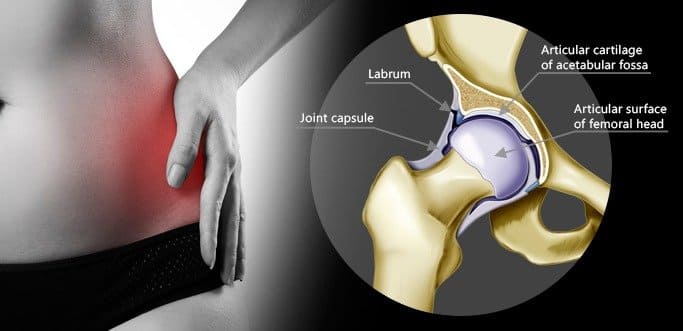No matter what the underlying cause of hip pain is, it can easily become a big problem, adding a great deal of discomfort. Both elderly and young people suffer from hip pain, which can drastically affect every aspect of daily life. When hip pain is combined with the discomfort of osteoarthritis, discomfort from a strained muscle, groin pain, discomfort in the lower back, knee pain, bursitis, or other conditions like femoroacetabular impingement, the affected person is going to require a comprehensive course of therapy.
Every person’s hip joint contains a special receptacle known as the acetabulum, which is further subdivided into the pubic, ilium, and ischium bones. The acetabulum is a kind of socket which connects to the tip of the leg bone via a piece of connecting tissue called the labrum. The labrum is circular in shape, and functions much like a shock absorber, helping to protect and increase stability in the hip. In everyone’s hip there are also two specialized muscles, known as flexor and extensor muscles, that run across the hip joint. These connect to the muscles in the leg and are how a person is able to bend and straighten their knees. In addition, two other muscles known as abductors and adductors connect the pelvic bone to the pubis, adding greater stability to the hip. It is when all of these interconnected muscles work properly that a person is able to walk and perform other movements. The hip also contains two tendons known as rotators, which make sure that the leg can twist and bend as we move. It is only when all of the various parts of the hip are understood that identifying and treating sources of hip discomfort can be properly treated.
While no discomfort is welcomed by a person suffering from hip or groin pain, the official definition of this is when a person experiences stiffness in the region in the morning, or cannot rotate their hips by more than 15 degrees without experiencing discomfort.
Discomfort in the hip and groin area can occur in anyone, but some people are particularly prone to this discomfort:
- Adults over 50 years old
- People with a hip developmental disorder
- Anyone who has previously suffered an injury to the hip
It is common for many people who experience discomfort in the hip to also feel pain in the groin, knee, leg, and ankle. Many people who suffer from hip discomfort in combination with other forms of pain are between the ages of 20 and 40, and have spent years participating in athletic or other physically strenuous activities. Patients who experience pain only in the hips are generally between 50 and 80 years old. While sometimes the pain in the hip or groin area is described as piercing or sharp, in other cases it may feel more like a pinched or numb feeling. In some cases, a person may feel or hear an audible clicking noise as they walk, which probably indicates that there is some dysplasia of their hip. Only after a careful analysis of the complete anatomy of the hip can a medical professional identify the cause and source of the discomfort.
Treatment for these conditions begins with a course of education, learning how to modify and adjust the way they perform everyday activities. Certain exercises and stretches are also effective for minimizing discomfort and improving flexibility, endurance, and strength. Obese people who suffer from hip discomfort can also greatly benefit by reducing their weight, as well as learning other techniques for reducing the amount of stress load that they place on the joint.
Doctors can also provide what is called manual therapy, or the use of special hands-on techniques for loosening and relaxing the hip muscles and tendons. This is a great way to reduce the amount of pain in the area, and help increase the mobility and flexibility of the hip.
A variety of physical therapy options are also available, including what are known as assisting devices, like walkers, crutches, and canes. Used properly, these devices will help a person suffering from discomfort regain their mobility while reducing the amount of weight and stress that they are placing on their hip.



























































